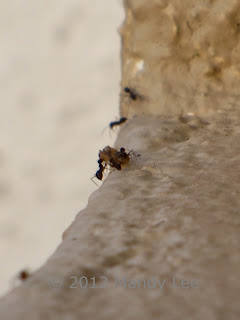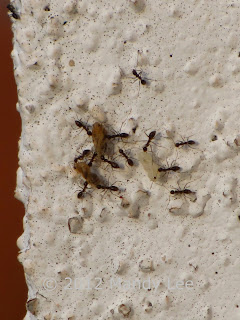Feeding, feeding, feeding.
Feeding of the eagles, macaques and monitor lizards in the 'wild'. Endless feeding! All these activities are carried out by some irresponsible tour operators and tour guides to increase the opportunities for better photo capture of these creatures and to ensure they will be there for viewing, to cater to demands of some sometimes ignorant and oblivious tourists in Langkawi.
And it is wrong! Very, very wrong indeed.
Not only does it create a dependency on humans by the animals but it changes the behaviour of these animals as well, in particular, the feeding behaviour.
Would this be the fault of the tourists or are the tour operators at fault? A bit of both, probably but more so for the tour operators! Shame on them! They should be creating the awareness among their guests on their tours about not feeding rather than allowing it.
No, I do not have photos to show what is happening and by who..... And, yes, I am still feeding the fishes at the fish farm, which I often refer to as the 'fish zoo', to ensure there will not be any mistreatment by the fish farm boys of the fishes that live within those net enclosures, especially of the stingrays and the eels.
Anyway, the reason I am bringing this up now is because I have had an interesting conversation with a Middle Eastern tourist about the feeding of the Long-tailed Macaques. This happened while I was with my guests at the Bat Cave in the Kilim Karst Geoforest Park just several days ago.
As usual, there was a troop of Long-tailed Macaques sitting on the mangrove trees and along the walk path that winds through the cave. This troop of monkeys are used to being fed by people. They hang out here on a regular basis, often just sitting around waiting to be fed and waiting to prey on unsuspecting tourists who had stepped off the boats holding bags of potato chips and soft drinks. On this afternoon, several were prowling about and by the looks of things, not to mention the amount of rubbish strewn about, these monkeys have had a field day taking and getting food from tourists and have been having a feast!
This happens all the time, particularly during the busy seasons when there are certain local Malaysian tourists, certain Asian tourists and Arab tourists visiting these tourist hot spots. These are groups of people who seem to think they know better about what they are doing and are always keen to feed the animals so that they can take a few photos, get in a few laughs watching the antics of the animals as they eat and when the monkeys chase each other or fight among themselves to get at the food. This same group of tourists also do not think twice when they mindlessly chuck rubbish everywhere wherever they go. And it doesn't help that the boat drivers who ferry these tourists are completely mute when it comes to informing these tourists about park regulations.
Where are those LADA appointed Park Rangers? This is one of the areas where their presence could at least make a bit of difference to the environment but they are nowhere to be seen!
Anyway, I was standing there with my guests, under one of the huts outside the cave, while I explained to them about these Long-tailed Macaques - the general behaviour, the do's and don'ts, et cetera - as we watched a troop of monkeys and a few of the babies sitting and playing on the branches nearby, just over a metre away from us.
It had started raining again and all the other tourists who were on the walk path just a few minutes earlier had all scrambled back into the cave for cover and back to their boats.
Good riddance, in a way! And we now have the whole place to ourselves!
Out of the blue, this Middle
Eastern couple started walking briskly towards us, stopped next to me, and the guy started asking me questions. Here's how the conversation went, word for word, exactly as I remembered it:
Tourist: Is this the harmful monkey?
Me: Huh? What do you mean?
Tourist: The harmful monkey, you know. They tried to bite us.
Me: What were you doing that the monkey tried to bite you?
Tourist: I was feeding it.
Me: Why did you feed the monkey? It's because you were feeding the monkey that it tried to bite you because the monkey wanted the food you were holding in your hand.
Tourist: So what can I do?
Me: Don't feed the monkeys! See?
(Pointing at my guests) We are standing here looking at the monkeys, we are not feeding the monkeys, we are not holding any food and they don't bite us!
Tourist: So if I don't feed them, they will not bite us?
Me: Of course, if you are not holding food in your hand and don't try to feed them, they won't bite you. So don't feed the monkeys!
Tourist: Oh......
Thank you.
And the couple scrambled back towards the cave..... in the rain.
Should I laugh? Or cry?
One of my guests who had been listening intently to the conversation then asked me, "Did they actually walk out here in the rain just to ask you that?
"
So I did have a laugh after all! And my guests too. We all did!
Anyway, I hope that tourist had learned his lesson. Perhaps he will even share his story with his family and friends and hopefully a few more people might stop feeding these animals?
It's a big fat chance that would happen at all. I know. But I can hope, can't I?
There is always that element of hope...........
even if just a flicker...............
























































